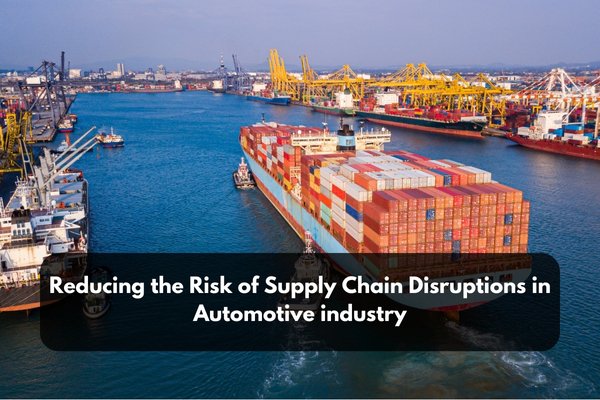Navigating the intricacies of Supply Chain Management and Logistics in the Automotive Sector, this piece addresses industry challenges. It explores issues ranging from visibility gaps and the repercussions of COVID-19 to environmental sustainability and geopolitical risks. Offering actionable insights, the narrative emphasizes the key roles of technology integration, collaborative partnerships, resilient supply chain design, strategic inventory management, and effective risk mitigation planning. These strategies are crucial for overcoming challenges and ensuring the automotive supply chain’s resilience and competitiveness in the future.
What is Supply Chain Management and Logistics in the Automotive Sector?
Supply Chain Management (SCM) and Logistics in the automotive sector involve the strategic coordination and optimization of various processes to ensure the seamless flow of materials, information, and products from suppliers to manufacturers, and ultimately to end consumers. SCM encompasses the entire lifecycle, from raw material procurement to production and distribution. Logistics specifically focuses on the physical movement of goods, encompassing transportation, warehousing, and inventory management.
In the automotive industry, effective SCM and logistics are vital for minimizing costs, optimizing production schedules, and meeting customer demands. These functions also play a critical role in navigating challenges such as supply chain disruptions, global sourcing, and the integration of advanced technologies to enhance efficiency and competitiveness in the dynamic automotive landscape.
Issues of Logistics and Supply Chain Management in Automotive Industry
Lack of Visibility in Supply Chain
A pervasive challenge in logistics and supply chain management is the lack of visibility across the entire supply network. This hampers real-time tracking of inventory, transportation, and production processes. Inefficient communication and data silos contribute to this issue, leading to delays, excess inventory, and increased costs. Overcoming this challenge requires implementing advanced technologies such as RFID, IoT, and blockchain to enhance transparency and enable stakeholders to make informed decisions.
The Impact of COVID-19
The COVID-19 pandemic has disrupted global supply chains, highlighting vulnerabilities in existing systems. Lockdowns, travel restrictions, and workforce shortages have led to production slowdowns and transportation delays. Companies faced challenges in securing raw materials and struggled to meet fluctuating consumer demands. To build resilience, organizations are reevaluating supply chain strategies, diversifying sourcing options, and adopting digital solutions for remote collaboration and risk mitigation.
Environmental Challenges
The logistics and supply chain industry faces increasing pressure to address environmental sustainability. High fuel consumption, emissions, and excessive packaging contribute to ecological concerns. Companies are adopting eco-friendly practices such as green logistics, alternative transportation methods, and sustainable packaging to reduce their carbon footprint. Balancing economic viability with environmental responsibility is crucial for long-term success and meeting evolving consumer expectations for environmentally conscious practices.
Political and Trade Risks
Political instability and trade disputes introduce significant risks to global supply chains. Changes in tariffs, trade agreements, and geopolitical tensions can disrupt the flow of goods and impact sourcing strategies. Companies need to closely monitor geopolitical developments, diversify suppliers, and implement contingency plans to navigate uncertainties in international trade. Additionally, fostering strong relationships with government agencies and staying informed about regulatory changes are essential to managing political and trade risks effectively.
Increasing Bureaucracy
Rising bureaucratic complexities, such as customs procedures and regulatory compliance, pose challenges to the efficiency of supply chain operations. Cumbersome documentation processes and inconsistent regulatory standards across borders can lead to delays and increased costs. To streamline operations, companies are leveraging technology for automated compliance management, adopting standardized documentation practices, and investing in training to ensure staff is well-versed in navigating complex regulatory landscapes. Proactive measures are essential to minimize the impact of increasing bureaucracy on supply chain efficiency and effectiveness.
How to overcome Issues of Logistics and Supply Chain Management in the Automotive Industry?
Technology Integration
Embrace advanced technologies like Internet Of Things (IoT), RFID tagging, and blockchain to enhance visibility and traceability across the automotive supply chain. Implementing real-time tracking and data analytics can optimize inventory management, minimize disruptions, and improve overall efficiency.
Collaborative Partnerships
Foster strong relationships with suppliers, manufacturers, and logistics providers. Collaborative partnerships can facilitate better communication, risk-sharing, and coordinated efforts to address challenges collectively. Shared information and transparent communication are key to mitigating disruptions and ensuring a smoother flow of goods.
Resilient Supply Chain Design
Design a resilient supply chain by diversifying sourcing strategies and establishing alternative suppliers. This helps mitigate risks associated with geopolitical uncertainties, trade disputes, or disruptions in the supply chain. Redundancy in critical components and agile manufacturing processes can enhance flexibility in response to unforeseen events.
Strategic Inventory Management
Implement efficient inventory management practices to balance the costs of holding inventory against the risks of stockouts. Utilize demand forecasting tools and just-in-time inventory strategies to optimize stock levels, reducing excess inventory costs while ensuring availability to meet customer demands.
Risk Mitigation Planning
Develop comprehensive risk mitigation strategies that account for potential disruptions, whether caused by natural disasters, political events, or global health crises. Regularly review and update these plans to stay agile in response to evolving challenges. Conducting risk assessments and scenario planning helps identify vulnerabilities and develop proactive strategies to address them before they impact operations.
In conclusion, the complexities of the automotive logistics and supply chain landscape demand strategic solutions to navigate challenges and ensure sustained industry excellence. Overcoming issues such as lack of visibility, global disruptions, environmental concerns, political risks, and bureaucracy requires a holistic approach. By embracing advanced technologies, fostering collaborative partnerships, designing resilient supply chains, implementing efficient inventory management, and developing comprehensive risk mitigation plans, the automotive industry can fortify its logistics and supply chain for a resilient and competitive future.



